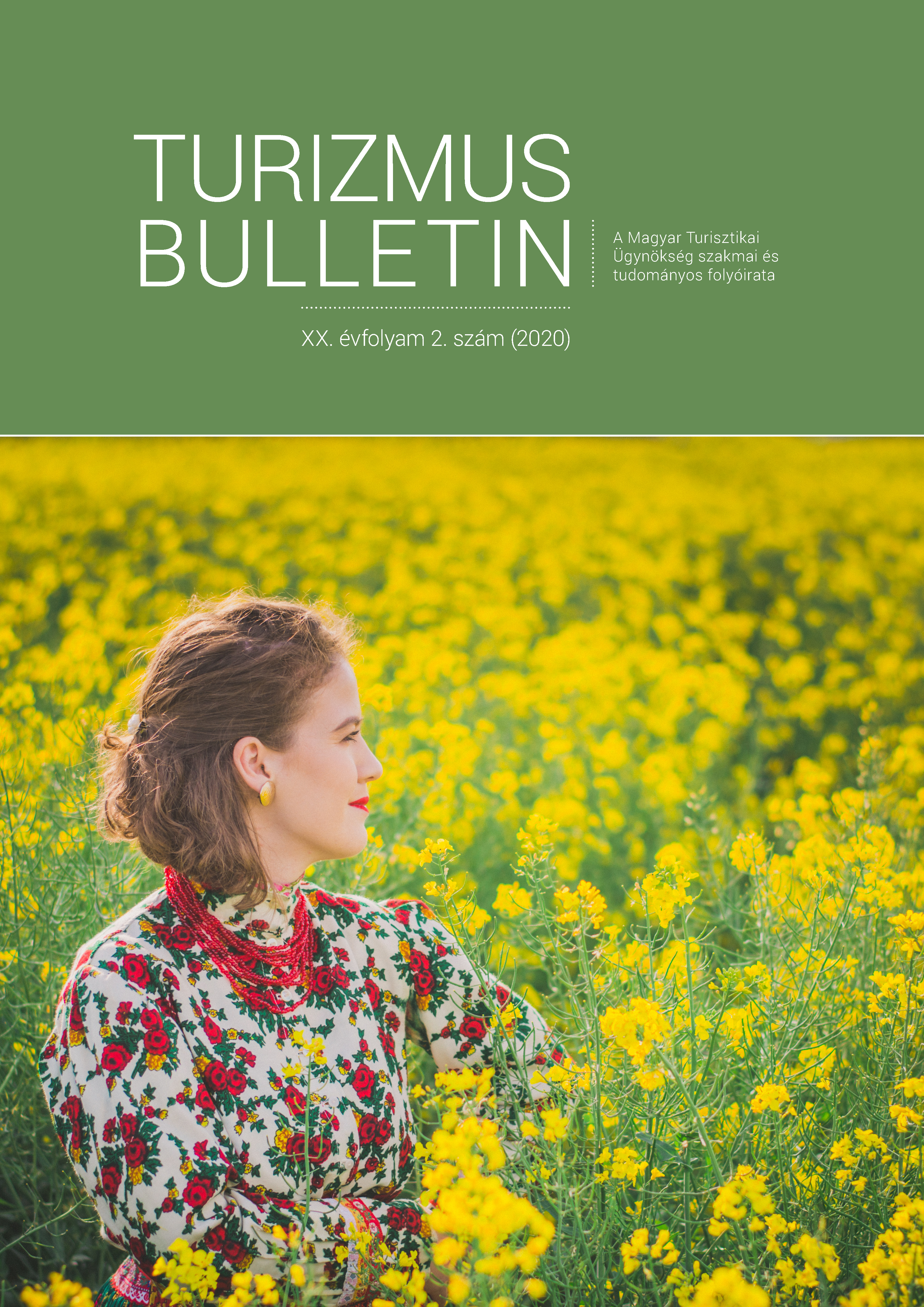Eszképizmustól az ajánlásig – Élményfokozatok és hatásai a romkocsmákban
DOI:
https://doi.org/10.14267/TURBULL.2020v20n2.2Kulcsszavak:
eszképizmus, transzformáció, emlékezetes élmények, romkocsmaAbsztrakt
Az egyedülálló hazai turisztikai kínálat, kulturális élet meghatározó jelenségei a rom- és artkocsmák. Tanulmányunk az egyedi turisztikai attrakciót egy újabb perspektívából közelíti meg. Holisztikus élménymegközelítést alkalmazva az egyénre fókuszálunk. A turisztikai élmény fontos összetevője az egyéni elkötelezettség, átélés, mely kiválthat emlékezetes élményeket, így befolyásolva a szolgáltatás további fogyasztását. Egyéni szinten az eszképizmus egyfajta aktivitást, bevonódást jelent az élmény során. Ez az átélés vezethet egy mélyebb kapcsolathoz, mely egyéni átalakulást eredményezhet. A szolgáltató részéről megfogalmazódhat a kérdés, hogy az élmény mennyiben befolyásolja a fogyasztók elégedettségét és a szolgáltatás további ajánlását. A kutatás célja az élményfokozatok: az eszképizmus, a transzformáció és az emlékezetes élmények vizsgálata egyéni szinten. További cél az élményhatások, az elégedettség és az ajánlás összefüggéseinek elemzése. Eredményeinket tematikus turisztikai attrakciók és vendéglátóegységek menedzsmentjének ajánljuk.
Hivatkozások
ALI, F. – HUSSAIN, K. – R AG AVA N, N. A. (2014): Memorable customer experience: Examining the effects of customers experience on memories and loyalty in Malaysian resort hotels. Procedia-Social and Behavioral Sciences. 144. pp. 273 – 279. https://doi.org/10.1016/j.sbspro.2014.07.296
ÁSVÁNYI K. – MITEV A. Z. – JÁSZBERÉNYI M. (2018): Családbarát fesztivál, avagy a családok fesztiválélménye. In: Józsa L. – Korcsmáros E. – Seres-Huszárik E. (szerk.): A hatékony marketing.
EMOK 2018 Nemzetközi Tudományos Konferencia konferenciakötete. Selye János Egyetem, Komárno. pp. 289 – 300.
BLAZQUEZ-RESINO, J. J. – MOLINA, A. – E ST EBA N -TAL AYA, A. (2015): Service-Dominant Logic in tourism: the way to loyalty. Current Issues in Tourism. 18(8). pp. 706 – 724. https://doi.org/10.1080/13683500.2013.863853
DIECK, T. M. C. – JUNG, T. H. – RAUSCHNABEL, P. A. (2018): Determining visitor engagement through augmented reality at science festivals: An experience economy perspective. Computers in Human Behavior. 82. pp. 44 – 53. https://doi.org/10.1016/j.chb.2017.12.043
DIJKSTRA, T. K. – HENSELER, J. (2015): Consistent partial least squares path modeling. MIS quarterly. 39(2). pp. 297 – 316. https://doi.org/10.25300/MISQ/2015/39.2.02
FORNELL, C. – LARCKER, D. F. (1981): Structural equation models with unobservable variables and measurement error: Algebra and statistics. Journal of Marketing Research. 18(3). pp. 382 – 388. https://doi.org/10.2307/3150980
HAIR, J. F. – BL AC K, W. C. – BABIN, B. J. – ANDERSON, R. E. – TATHAM, R. L. (2006): Multivariate data analysis. 6th Edition. Pearson Prentice Hall. New Jersey.
HOSANY, S. (2016): The effects of self-image congruence, Tourists’ experiences and satisfaction on behavioral intention. Travel and Tourism Research Association: Advancing Tourism Research Globally. 4. University of Massachusetts Amherst.
HOSANY, S. – WITHAM, M. (2010): Dimensions of cruisers’ experiences, satisfaction, and intention to recommend. Journal of Travel Research. 49(3). pp. 351 – 364. h t t p s : //d o i .org/10.1177/0047287509346859
HU, L. T. – BENTLER, P. M. (1999): Cutoff criteria for fit indexes in covariance structure analysis: Conventional criteria versus new alternatives. Structural Equation Modeling. 6(1). pp. 1 – 55. https://doi.org/10.1080/10705519909540118
HUANG, S. – SHEN, Y. – CHOI, C. (2015): The effects of motivation, satisfaction and perceived value on tourist recommendation. Travel and Tourism Research Association: Advancing Tourism Research Globally 5. University of Massachusetts Amherst.
IVÁNYI, T. – BÍRÓ-SZIGETI, T. (2019): Measuring customer satisfaction and factors of experience in the case of tourism events and festivals. Proceedings of the 9th International conference on management. People, Planet and Profit: Sustainable business and society. Volume I. Szent István University, Gödöllő, Hungary. pp. 253 – 260. https://doi.org/10.17626/dBEM.ICoM.P01.2019.p036
JUROWSKI, C. (2009): An examination of the four realms of tourism experience theory. International CHRIE Conference-Refereed Track.23. pp. 1 – 8. https://scholarworks.umass.edu/cgi/viewcontent.cgi?article=1054&context=refereed
KELEMEN-ERDŐS A. – MITEV A. (2016): Holisztikus szolgáltatásélmény: vendég-utazás és kölcsönös értékteremtés dimenziói az art- és romkocsmák példáján. Marketing & Menedzsment. 50(3-4). pp. 88 – 101.
KIRILLOVA, K. – LEHTO, X. – CAI, L. (2017): Tourism and existential transformation: An empirical investigation. Journal of Travel Research. 56(5). pp. 638 – 650. https://doi.org/10.1177/0047287516650277
LENGYEL A. (2019): A mindfulness és liminalitás felértékelődése: spirituális elvonulási központok, a fenntartható jövő desztinációi? Turizmus Bulletin. 19(1). pp. 14 – 24.
MITEV A. – IRIMIÁS A. R. – MICHALKÓ, G. (2017): Rítusba oltott átalakulás: transzformáció a vallási turizmusban. In: Régi T. – Rátz T. – Michalkó G. (szerk.): Turizmus és transzformáció. Turizmus Akadémia 8. Kodolányi János Főiskola, MTA CSFK Földrajztudományi Intézet, Magyar Földrajzi Társaság, Orosháza–Budapest. pp. 37 – 50.
PINE, B. J. – GILMORE, J. H. (1998): Welcome to the experience economy. Harvard Business Review. 76(4). pp. 97 – 105.
PINE, J. B. – GILMORE, J. H. (1999): The experience economy: Work is theatre and every business a stage. Harvard Business School Press, Boston.
REISINGER, Y. (2013): Transformation and transformational learning theory. In: Reisinger, Y. (ed): Transformational tourism: Tourist perspectives.CABI. Oxfordshire, UK & Boston, US. pp. 17 – 26.
RIJAL, C. P. – GHIMIRE, S. (2016): Prospects of creating memorable experience in Nepalese tourism and hospitality industry. Journal of Tourism and Hospitality Education. 6. pp. 40 – 66. h t t p s : //d o i . o r g /10.3126/jthe.v6i0.14767
RIVERA, M. – SEMRAD, K. – CROES, R. (2015): The five E's in festival experience in the context of Gen Y: Evidence from a small island destination. Revista Española de Investigación de Marketing ESIC. 19(2). pp. 95 – 106. https://doi.org/10.1016/j.reimke.2015.06.001
SEMRAD, K. J. – RIVERA, M. (2018): Advancing the 5E’s in festival experience for the Gen Y framework in the context of eWOM. Journal of Destination Marketing & Management. 7. (March) pp. 58 – 67. https://doi.org/10.1016/j.jdmm.2016.08.003
SIPE, L. J. – TESTA, M. R. (2017): From satisfied to memorable: An empirical study of service and experience dimensions on guest outcomes in the hospitality industry. Journal of Hospitality Marketing & Management. 27(2). pp. 178 – 195. https://doi.org/10.1080/19368623.2017.1306820
SMITH, M. (2013): Transforming quality of life through wellness tourism. In: Reisinger, Y. (ed): Transformational tourism: Tourist perspectives.CABI. Oxfordshire, UK & Boston, US. pp. 55 – 6 7.
ZÁTORI A. (2014): Az élménymenedzsment koncepcionális alapjai. Vezetéstudomány – Budapest Management Review. 45(9). pp. 57 – 66.
YI, Y. – GONG, T. (2013): Customer value co-creation behavior: scale development and validation. Journal of Business Research. 66(9). pp. 1279 – 1284. https://doi.org/10.1016/j.jbusres.2012.02.026

